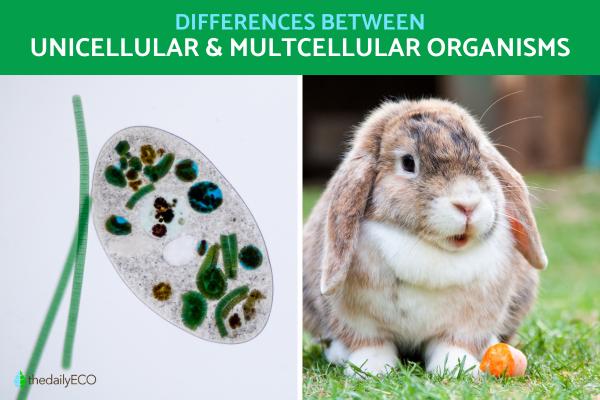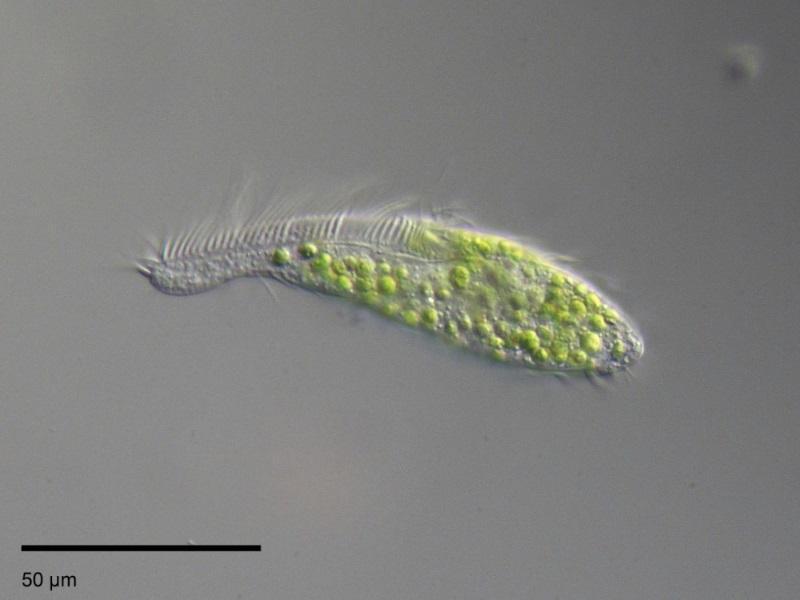Difference Between Unicellular and Multicellular Organisms With Examples


The difference between unicellular and multicellular organisms is the number of cells which make up the organism. Unicellular organisms have only one cell, whereas multicellular organisms have multiple cells. While this is the most stark comparison, the differences between unicellular and multicellular organisms are incredibly varied. The importance of having one or more cells is such that we group all living organisms as either unicellular or multicellular, although there are many other forms of classification.
At thedailyECO, we examine the difference between unicellular and multicellular organisms with examples of both. We provide more detailed definitions, as well as the characteristics of these differently structured beings.
What are unicellular organisms and their characteristics?
Also known as a single-celled organism, unicellular organisms are living beings which are formed by only a single cell. All of the processes which are required to carry out the various vital functions for life to occur happen within the walls of cells. This means that one cell on its own can be considered a living organism.
Unicellular organisms are mostly microscopic, but there are some which can be much larger. Some unicellular organisms can even be seen with the naked eye, such as xenophyophores, single-cell marine organisms which can reach sizes of up to 20 cm in diameter. These are types of foraminiferans which extract minerals from their environment to create protective shells known as tests.
Most unicellular beings are prokaryotic cells. This means they are cells that do not have a nucleus and their genetic material is not enclosed in a membrane. Instead, it is dispersed throughout the cytoplasm, as is the case with most bacteria.
There are other unicellular organisms that do have a nucleus, such as protozoa. These types of cells are called eukaryotic cells, which have a more complex structural organization and reach larger sizes than prokaryotic cells. You can learn more about these types of cells with our article on the difference between prokaryotic and eukaryotic cells.
Unicellular living beings can reproduce both sexually and asexually depending on the organism to which we refer. There are several asexual reproduction strategies, such as:
- Bipartition or binary fission: the nucleus and cytoplasm of the cell divides giving rise to two identical daughter cells.
- Budding in yeast: the nucleus divides and separates from the mother cell with a portion of the cytoplasm that generates the daughter cell.
- Sporulation: the nucleus divides several times and each one of them will generate a spore that will be released when the membrane of the mother cell is broken. Learn more with our article on sporulation in biology.
These beings are considered the most primitive living organisms. This is because their system is simpler than that of multicellular beings. This does not mean they are poorly adapted to living. On the contrary, unicellular organisms are significantly more abundant in nature than multicellular organisms. They can live in very remote places where other forms of life cannot develop, including in the tissues of other organisms.

Examples of unicellular organisms
Unicellular organisms have representatives of some kingdoms of living beings. They include:
- The kingdom Monera, made up of single-celled bacteria.
- Some organisms of the kingdom Protista.
- The yeasts of the kingdom Fungi.
ORagnisms from the kingdom Animalia are more complicated multicellular organisms. For this reason, there are no unicellular animals, at least from a taxonomic perspective.
As we have stated above, the majority of types of living beings are single-celled organisms. This means we cannot list all of them here. We can provide some key examples of unicellular organisms in nature:
- Yeasts such as Saccharomyces cerevisae (brewer's yeast)
- Escherichia coli (bacterium)
- Toxoplasma gondii (protozoan responsible for toxoplasmosis)
- Trypanosoma cruzi (protozoan that causes Chagas disease)
- Trichomonas vaginalis
- Candida albicans (responsible for candidiasis)
- Mycobacterium tuberulosis (bacterium responsible for tuberculosis)
- Neisseria gonorreae (bacterium that causes gonorrhea)
- Mycoplasma pneumoniae (bacterium responsible for pneumonia)
- Clostridium botulinum (bacterium that causes botulism)
- Pneumococci (bacteria)
- Staphylococci (bacteria)
- Dinoflagellates (protista)
- Some unicellular algae such as diatoms
- Paramecia (protista)
We provide another comparison of similar organisms with our article on the differences between bacteria and viruses.

What are multicellular organisms and their characteristics?
As their name indicates, multicellular organisms are those made up of two or more eukaryotic cells. They present a greater complexity than unicellular organisms in terms of the functions that they develop.
These multicellular organisms arose from a primitive unicellular organism. The process by which this jump to multicellularity occurred is one of the great unknowns in evolutionary biology, with several hypotheses proposed to explain their development. We do know that this evolutionary jump occurred several times simultaneously in different groups of various organisms, such as animals, terrestrial plants, algae and fungi.
All current multicellular organisms originate from a single cell, meaning they begin life as unicellular organisms. This includes us humans since we develop from a zygote. This is the cell resulting from the union of the male and female sexual gametes during fertilization.
Zygotes divide and multiply, giving rise to a multicellular organism whose cells will undergo differentiation processes and will work independently and together. When they do so, they form the tissues, organs and systems that will make up the individual's body. In some groups of simpler species (such as sponges), no true tissues are formed. For this reason, their cells function with greater independence.
The cells of multicellular organisms reproduce asexually through two processes:
- Mitosis: daughter cells identical to the mother cell and with the same number of chromosomes are produced.
- Meiosis: typical of the reproductive cells whose purpose is to originate the gametes with half of the genetic endowment from each parent organism.
The reproduction of multicellular organisms is more varied and can be based on sexual reproduction or asexual reproduction. Learn more with our guide to the difference between cellular mitosis and meiosis.
Examples of multicellular organisms
There is a great diversity of multicellular organisms, although unicellular living beings far exceed this multicellular diversity. Even so, if we want to give some examples of multicellular living beings, we find a wide range that ranges from fungi to animals and plants:
- All vertebrate animals: these all belong to the Animal Kingdom, such as mammals, birds, reptiles, amphibians, fish and even ourselves.
- All invertebrate organisms: such as sponges, annelids , arthropods, etc.
- Plants: within the plant kingdom we can find all the variety of terrestrial plants, such as mosses, liverworts, angiosperms or gymnosperms, among many other groups. All plants are multicellular.
- Algae: such as green algae, red algae and brown algae. While these types of algae are multicellular, there are also types of unicellular algae.
- All fungi: except for unicellular yeasts.
Cyanobacteria is an organism which can be multicellular or unicellular. Interestingly, cyanobacteria few prokaryotic phyla where multicellularity has evolved[1]. They are considered an important case study in understanding evolutionary adaptation.

Differences between unicellular and multicellular organisms
After knowing providing several examples of unicellular and multicellular organisms, we will discuss in a little more detail how they differ. These are the main differences between unicellular and multicellular organisms:
- The main difference, as we have already mentioned from the beginning, is the number of cells that these living beings have. Unicellular have only one cell and multicellular have more.
- Unicellular organisms can be part of the group of prokaryotes and eukaryotes, while multicellular organisms are only part of eukaryotic living beings.
- There is a difference in the size of unicellular and multicellular organisms, the former being mostly smaller than the latter.
- Unicellular living beings have more resistance to extreme environmental conditions than multicellular ones.
- Unicellular living beings do not make up complex structures, such as tissues, organs and systems, while multicellular ones do.
Below you can see the comparative table of differences between unicellular and multicellular organisms:

If you want to read similar articles to Difference Between Unicellular and Multicellular Organisms With Examples, we recommend you visit our Biology category.
1. Schirrmeister, B. E., Antonelli, A., & Bagheri, H. C. (2011). The origin of multicellularity in cyanobacteria. BMC evolutionary biology, 11, 45.
https://doi.org/10.1186/1471-2148-11-45








